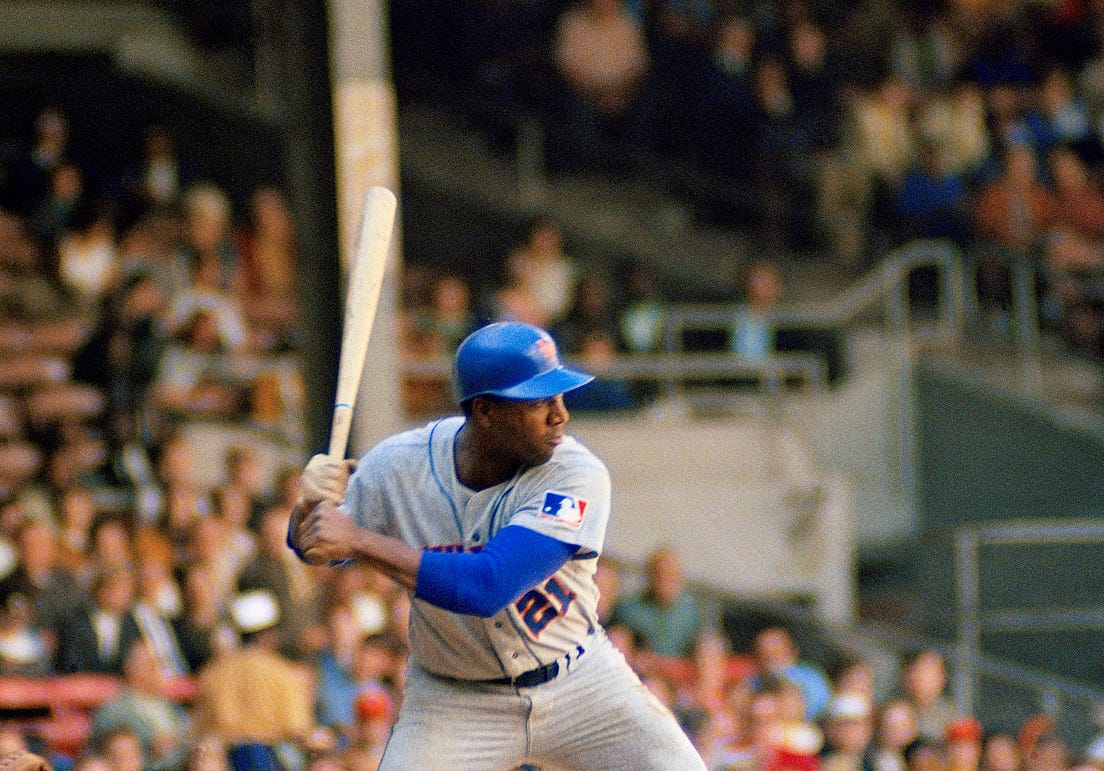We’re looking back at the 50th anniversary of the Mets’ 1973 National League pennant-winning team by reviewing the most inspirational figures of that remarkable run. We continue with a hero of 1969 who while he didn’t have the same year-long success as four years before was instrumental when it counted most.
It’s impossible to think about the Miracle Mets season and not think about Cleon Jones. The catch in left field to end the World Series of course, but also as the most significant offensive contributor throughout the season.
He had his best year in 1969. As it turned out, so did the Mets. Four years later, Jones struggled to stay healthy. It was almost a lost season both for the individual and the team. But, Jones healed up enough in September. As it turned out, so did the Mets. Jones was a crucial part in New York’s 11th-hour charge to the division title. He batted .278 after September 19, belted six home runs, and collected 14 RBIs, leading the charge as the Mets emerged from a crowded six-team scramble with the division crown.

Cleon Jones – Photo Courtesy of NewYorkMets.medium.com
Jones had been a part of the franchise dating back to the inaugural season. Drafted on July 5, 1962, the team got looks at Jones in ’63 and ’65, with a significant minor-league stint in between. He gave brief glimpses of what was to come, but not before learning some hard lessons. Jones got himself into a tailspin he couldn’t get out of in 1967. Prolonged slumps, benchings, and public criticism from manager Wes Westrum: a thumbnail sketch of a forgettable year.
Transformative changes were on the horizon for Jones. First, Gil Hodges was brought on as manager that November. A month later, New York acquired Tommie Agee, a fellow Mobile, AL native as well as Cleon’s high school friend and teammate. The trade for Agee to the Mets from the White Sox provided more than just a familiar face in the clubhouse. It moved Jones from center field, a spot with which he was never comfortable, to left field.
A relaxed Cleon started fast in 1969, hitting .410 for April, blasting five homers in May, and posting a June batting average of .341 to catapult the Mets into challenging the Cubs for first place. It made Jones an All-Star starter and, he eventually finished third in the batting race. While the ’69 season was undoubtably Jones’s best, his best two weeks came during the pennant chase of 1973 as he salvaged what was nearly a lost year.
Jones, like much of the Mets roster, couldn’t escape an onslaught of injuries threatening to keep New York out of NL East title contention. Heading into September, Cleon’s bum leg had reduced him to 70 games. His bat and body were almost completely void of power with only five home runs (two on Opening Day) and 12 doubles. Despite the bothersome knee, Jones rediscovered his potent swing.
New York didn’t as much win the East as they survived it. The Mets showed they were the best team—and the luckiest. Never was there a better example than on September 20, when Jones took part in a play that indicated there was still some magic left from ’69.
With two outs and Richie Zisk on first in the top of the 13th against first-place Pittsburgh, Dave Augustine sent one beyond Jones’s reach in left field—destined to land in the Mets bullpen. But this ball had Mets destiny written all over it. The trajectory bounced it squarely off the top of the fence and back toward Jones. An inch farther, it’s a home run. An inch shorter, it’s an awkward ricochet. In either instance, a run scores.
Jones caught it from the rebound, turned, and fired to cutoff man Wayne Garrett while Zisk rounded third and headed home. Garrett threw to catcher Ron Hodges, who laid down the tag on a sliding Zisk.
“We were very fortunate to be able to make a play on that,” he said. “That was the turning point in the Mets winning the championship.”
Jones’s contributions to the Mets as they journeyed again through the NLCS and up to the seventh game of the World Series were timely if not nearly as significant.
His power subsided, but his Game 2 ninth-inning RBI single made way for three additional runs and provided the necessary cushion in a 5-0 victory. A wall-banging double in the bottom of the fifth in Game 5 broke a 2–2 tie in what would become a 7–2 pennant-clinching victory. Clutch hits were harder to come by in the seven-game World Series defeat to Oakland. He went 8-for-28 with three extra-base hits and a Game 2 homer.
The injuries proved too much to overcome afterwards and an unfortunate dismissal from the team in 1975 made for an abrupt ending to a terrific Mets career. Upon his exit, Jones had more hits, more home runs, and more RBIs than any other Met while playing a significant part in two pennant-winning teams and a world championship. It’s clear that no everday player in the first dozen years of this franchise was more impactful.
















